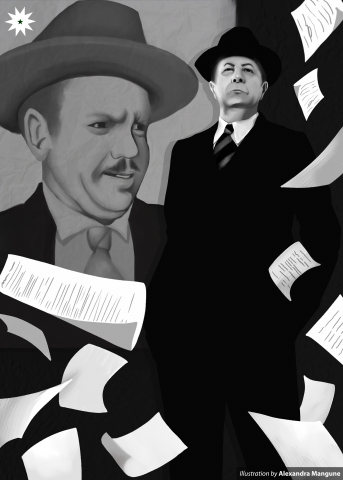
The moment audiences saw Citizen Kane’s groundbreaking snowglobe shot, the clever play with lighting, and the long pan back in 1941, its place as one of cinema’s greatest was cemented. It would go on to define many of the textbook filmmaking techniques we see today.
The film’s praises were sung to 24-year-old newcomer director Orson Welles who also produced, co-wrote, and starred in the film. But much of the buzz was on the story itself: was the protagonist Charles Foster Kane based on media mogul William Randolph Hearst? In an industry of zanies and gangster flicks, how did the onscreen adaptation of a newspaper tycoon’s hunger for power manage to rock a few skeletons in the closet? Moreover, the controversy surrounding the authorship of its screenplay would also hound the film for years—with Welles claiming the bulk of the screenwriting credit and co-writer Herman J. Mankiewicz contesting this, the question of whose genius brought forth the masterpiece being hotly-debated even to this day.
With Mank, David Fincher (The Social Network, The Curious Case of Benjamin Button, Gone Girl) dodges this question and instead unpacks a writer’s struggle with ego and injustice. He crafts a love letter to old Hollywood as we follow the grizzled and cynical Mankiewicz—Mank, if you will—who grapples with alcoholism and with an industry yet to make sense of its political and social atmosphere. A classic take on tinseltown, it is a reverent recognition of how one of the most influential screenplays in cinematic history came to be.
Old Hollywood renaissance
Known for his modern thrillers, there was some doubt as to whether Fincher can effectively helm a period piece that can do justice to Citizen Kane. But Fincher could not let its screenplay, written by his late father Jack Fincher, lay untold.
As soon as the long opening credits start rolling, viewers are taken back to a time of Hollywood glamor. One may recognize the long pans, tracking shots, and low angles that Citizen Kane has popularized in film history. Its visually appealing dimly-lit scenes and moody shadows pay homage to the noir of the early 30s and 40s. In a time of digitally-shot saturated modern-day dramas, Fincher and cinematographer Erik Messerschmidt make a terrific choice in giving the film a sense of nostalgia.
Despite the absence of color, much of the film’s allure comes from its 30s inspired wardrobe by Trish Summerville—who used long suits and bewitching dresses to mirror Hollywood’s big wigs. It is also endearing to see how production designer Donald Graham Burt brings back to life the grand sets and expansive studio lots of the Hollywood heydey. The film’s pizzazzy score, under the hands of frequent Fincher collaborators Trent Reznor and Atticus Ross, serves Old Hollywood’s love for jazz over crisp dialogue.
The plot thickens
Veteran Gary Oldman is astounding as Herman Mankiewicz; bringing to life the tortured screenwriter, he delivers razor-sharp wit and is genuine in his gradual disillusionment. Lily Collins gives a surprisingly luminous performance as Rita Alexander, a testament that given the right material and the right director, she can give everyone a run for their money. But the accolades would have to go to Amanda Seyfried, who gave the best performance of her career as Marion Davies. Initially introduced as media mogul William Hearst’s (Charles Dance) trophy mistress, the expectation was that she would be as shallow as the character she allegedly inspired in Citizen Kane. Seyfried turns this completely on its head, giving charm and nuance to Marion.
She, perhaps, embodies the film’s ethos more than anyone else—here is Marion Davies; banterer, kept woman, actress, and yet much more than can be encapsulated by a man’s words. This futility echoes throughout the film, with the titular character himself poignantly uttering, “You cannot capture a man’s entire life in two hours. All you can hope is to leave the impression of one.” Ironically, this is also the film’s weakness as the plot left much to be desired despite the bloated runtime. The flashback structure in homage to Citizen Kane actually weakens the story’s impact; the film seemingly too consumed by its flashy gimmick to actually render emotional depth to its characters. The Welles and Mank dynamic is not fleshed out, leaving one of its more interesting conflicts underutilized as the story sputters off to an underwhelming conclusion.
In black and white
Mank’s strength lies not in its visual spectacle, but in its daring to critique the majesty of the old Hollywood it also lovingly worships. What it ultimately contributes to Fincher’s rich body of work is an incisive political overtone never before explored in his previous films. In delving into Mank’s resentment of studios’ greed and bridging the intersection of media and power with present day political context, Fincher gave the film some of the teeth it desperately needed.
While some may say that Mank is almost too masturbatory in its glorification of a bygone age—too similar to its Oscar-bait ilk—Fincher’s gifted direction gives it a slight edge. Riddled with stunning visuals but bogged down by weak structure, Mank may be a hit-or-miss for audiences. However, one cannot overrule its intention to defy modern styles of filmmaking by going back to its roots, making it a definite 2020 standout. If one is looking to digress from contemporary dramas, might as well give Mank a try.
Rating: 3/4
